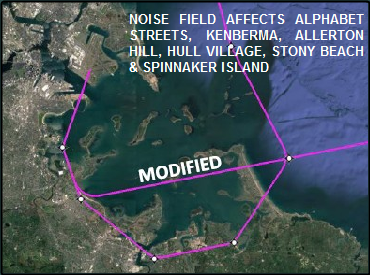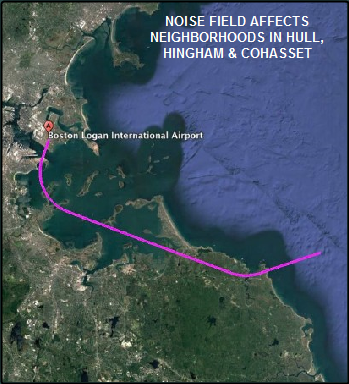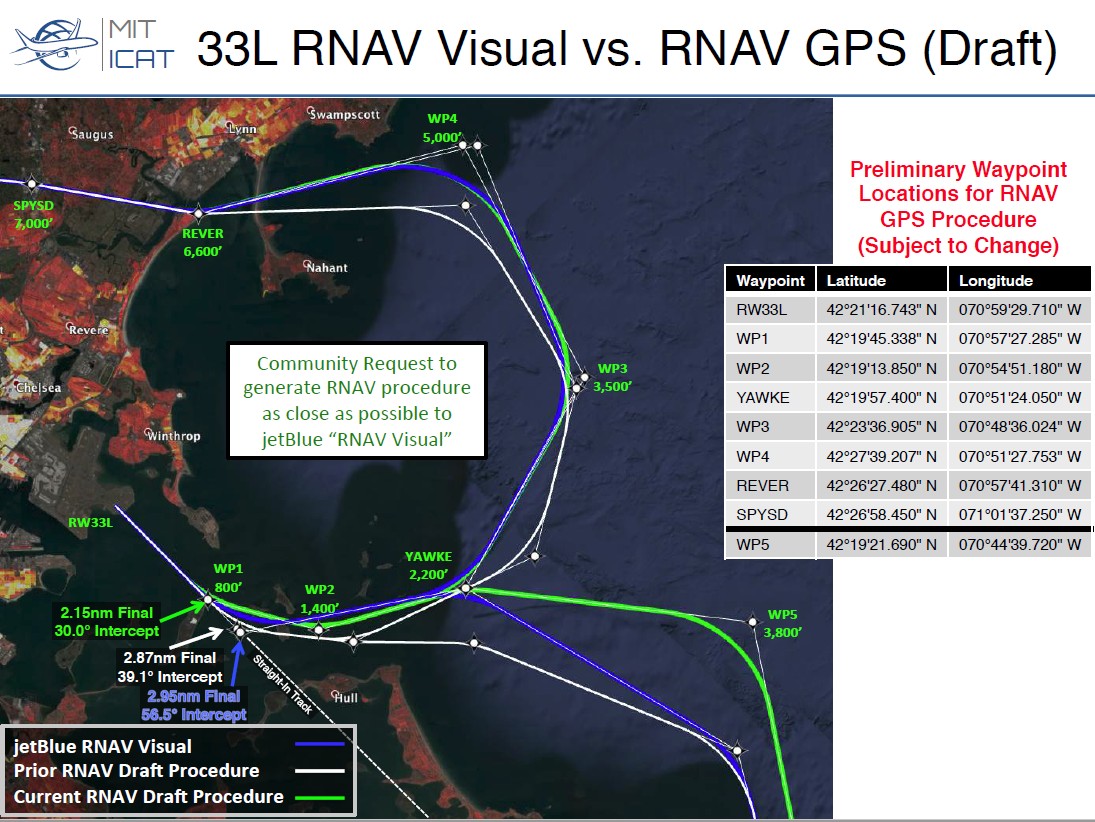With the advent of NextGen (the FAA's Next Generation Air Transportation System), and because of the small size of our town and its location on Boston Harbor, the Hull community has suffered beneath an onslaught of Logan Airport arrivals and departures that are impacting the health and well-being of our citizens. Hull lies beneath three heavily concentrated RNAVs that assault neighborhoods with over 90,000 overflights a year; a staggering number that includes runway 33L arrivals, 32 arrivals, 15R departures and 22R departures-- the latter shifted over Hull to provide noise relief for municipalities southwest of Boston like Braintree, Milton and Quincy. In addition, our community has become Massport’s primary destination for 11:00 p.m. to 6:00 a.m. overnight flights (including head-to-head operations), forcing families to sacrifice critical sleep for the benefit of Greater Boston; an unfair and unhealthy burden our citizens have shouldered for years. Furthermore, the enormous volume of aircraft has, and continues to have, a negative impact on property values; a situation that will be exacerbated as Logan Airport moves toward around-the-clock arrivals and departures.
Last year, the Federal Aviation Administration and Massport jointly sponsored a study conducted by MIT to find new methods of mitigating aircraft noise over communities in the vicinity of Logan International Airport. The first draft of that study was released earlier this year. The second draft was made public in September. For those interested in examining the September release, you can view the full document here: MIT STUDY
There are two major components to the MIT study; BLOCK ONE and BLOCK TWO. Block One proposals are considered less difficult to implement and will be discussed at the November 15th public meeting with Massport. Block Two proposals are considered a bit trickier to execute but are still very much on the table. Below is a synopsis of the aircraft noise and pollution issues affecting the town of Hull, followed by a synopsis of the Block One and Block Two proposals that impact our community.
There are two major components to the MIT study; BLOCK ONE and BLOCK TWO. Block One proposals are considered less difficult to implement and will be discussed at the November 15th public meeting with Massport. Block Two proposals are considered a bit trickier to execute but are still very much on the table. Below is a synopsis of the aircraft noise and pollution issues affecting the town of Hull, followed by a synopsis of the Block One and Block Two proposals that impact our community.
MIT STUDY: BLOCK ONE
HULL IN THE CROSSHAIRS
Logan Arrivals: Hull residents, noise-weary from departing and overnight air traffic over Boston Harbor, have concerns about the harm MIT’s Block One over-the-harbor approach might inflict. This proposed flight path has been reconfigured from what is known as the “JetBlue Light Visual”. The town of Hull endorsed the JetBlue track to reduce the number of arriving flights that impact neighborhoods on the Runway 33L approach skirting Hull Bay. MIT's engineers modified this flightpath (see below-new RNAV in green), and we are urging Massport and the Federal Aviation Administration to keep the track further offshore to give needed relief to our townspeople without placing the burden on other Massachusetts communities.
In order to take some of the load off Runway 4R arrivals (which primarily impact the town of Milton) the MIT study proposes several new flight paths (SEE BELOW) for use when winds blow from the north or northeast. This is known as the “Northeast Flow” runway configuration and is currently the only configuration that spares our town from Logan overflights. As proposed in the MIT study, aircraft on the 4R approach would avoid Milton by cutting across the Hull peninsula. Should any of these Runway 4R alternatives be enacted, our town would stand alone as the only Massachusetts community impacted by all four runway configurations; and since Logan Airport is unrestricted by curfew and moving toward around-the-clock operations, we would face the alarming prospect of being hammered by Logan noise 24 hours a day, 7 days a week, 365 days a year. The full study, including Block Two proposals can be viewed here: MIT STUDY
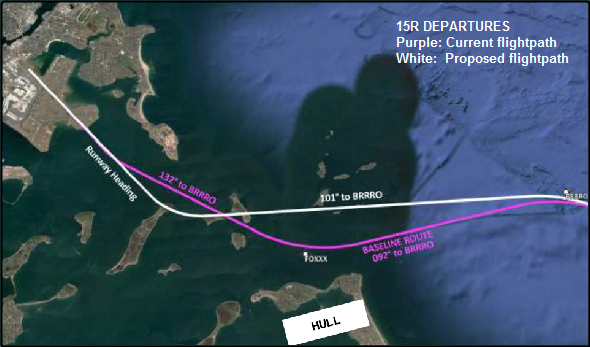
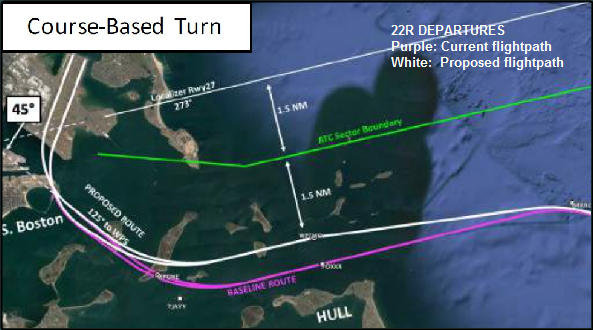
4R ALTERNATIVE RNAVS
NOTE: These flightpaths would be in addition to those already over Hull
NOTE: These flightpaths would be in addition to those already over Hull
MIT Study: Analysis and Response
Logan Departures: Departing flights affecting our community use runways 22R and 15R. The Federal Aviation Administration established these flight paths a few years ago to alleviate some of the noise over communities to our west. 22R departures head straight for Pemberton Point then turn up our coast past Hull Village and Allerton Hill. 15R departures (usually the larger aircraft) head for the area near the sewage treatment plant then bank left past Allerton Hill. Both tracks place Hull Village, Allerton Hill and points in-between squarely in the sound field. The MIT study proposes a quicker ascent for aircraft departing 22R and 15R and a tighter turn onto flight tracks further from the Hull shoreline; either over Boston Lighthouse or north of the lighthouse (SEE BELOW). Positive news for Hull if implemented. The up-to-date Block One proposals from MIT can be viewed here: MIT BLOCK ONE
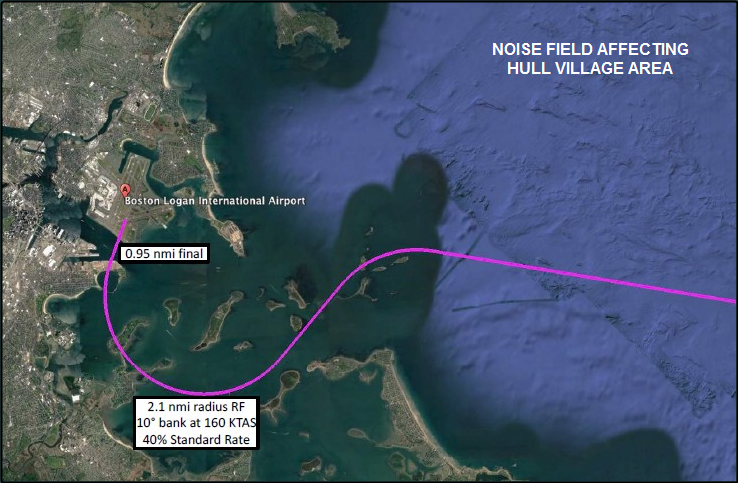
MIT STUDY: BLOCK TWO
